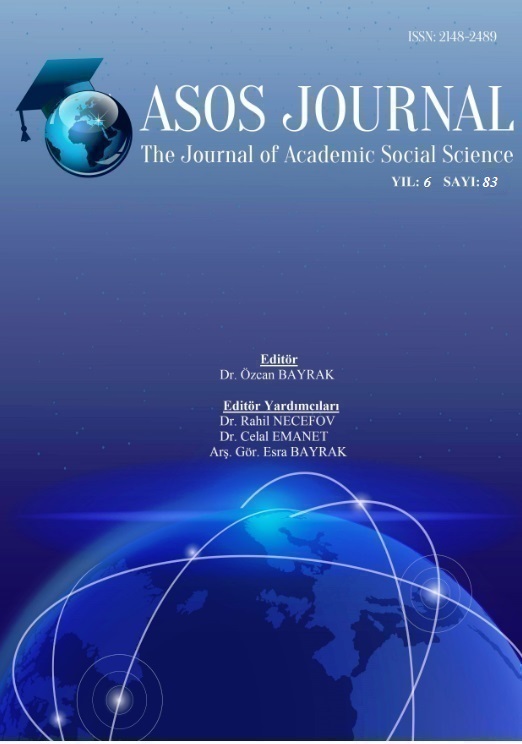Author :
Abstract
Tanzimat‘la Batı’ya açılan Osmanlı İmparatorluğu’nun idarî ve sosyal yapısı değiştiği gibi, fikri ve sosyal yapısı da değişmiştir. Bu değişimlerden en çok etkilenenler ise kamusal alanda varlık göstermeye başlayan kültürün yeniden üreticisi konumundaki kadınlardır. Bu dönemde, Türk modernleşmesinin önemli adımlarından biri olan; “toplumda kadının nasıl konumlandırılacağı meselesi” edebiyat ve sanat aracılığıyla çözülmeye çalışılmıştır. Dönemin yazarları, roman, hikaye, şiir ve tiyatro gibi türleri bu soruna çözüm üretme amacıyla araçsallaştırmışlardır. Osmanlı aydınlarının hemen hemen hepsi kadın meselesini konu aldıkları çalışmalarında, kadının eğitimi ve erkek karşısındaki eşitliğine odaklanmışlardır. Bu aydınlar toplumun bir bütün olarak ilerlemesi ve kadının toplumsal statüsünün yükselmesi için özellikle kadınların eğitim hakkını savunmuşlardır. Böylece Osmanlı toplumunda kısmî de olsa hissedilmeye başlayan laikleşme ve özgürleşme yönündeki farklılaşma, kız çocuklarının eğitim hakkına da yansımış ve kadın hak ve özgürlüklerine dair radikal kırılmalar görülmeye başlanmıştır. Osmanlı devletinin ulus devlet olma çabaları içinde yapılan reformların etkisi kadınlara da yansımış ve kadınlar, geçmişe oranla pek çok yönden olumlu değişimler yaşamaya başlamıştır. Dönemin oyunlarının pek çoğunda yazarlar; kadının bağımsız olabilmesini, bir birey olarak karar verip hareket edebilmesini genellikle erkek üzerinden bir kurguyla vermişlerdir. Bu dönemde oluşturulan sivil öğütlenmeler, çıkarılan gazeteler, yazılan şiirler, romanlar ve tiyatro oyunlarında kadının ele alınışı hep eşitlik zemini üzerine kurulur. Bu fikrin yaygınlaşması ve toplum tarafından içselleştirilmesi için tiyatro araç olarak kullanılır. Ataerkil yapı içerisinde; gerek dinin istismar edilmesi ve gerekse erkeğe yüklenen toplumsal rollerin bir sonucu olarak Osmanlı kadınının toplum dışına itilmesi, erkek karşısında eşitsizliği pek çok yazarın eserine konu olmuştur.
Keywords
Abstract
As the administrative and social structure of the Ottoman Empire opened to Tanzimat and the West changed, the idea and social structure of the Ottoman Empire changed as well. The most affected by these changes are the women who are the cultural producers who are starting to exist in the public arena. In this period, one of the important steps of Turkish modernization; Tried to be solved through "literature and art", "the issue of how women should be positioned in society". The authors of the period, such as novels, stories, poetry and theater, instrumentalized them in order to solve this problem. Almost all of the Ottoman intellectuals have focused on women's education and equality with men in their studies on women's issues. These intellectuals advocated the right of women to educate, especially as the society progressed as a whole and the social status of women was promoted. Thus, discrimination in the direction of secularization and emancipation which started to be felt in the Ottoman society in a partial sense was reflected in the right of girls to education and radical breaks in women's rights and freedoms started to be seen. The effects of the reforms of the Ottoman state in its efforts to become a nation-state have also been reflected in women, and women have begun to live positive changes in many ways compared to the past. Most of the plays of the period are writers; they were able to decide whether or not the woman could be independent and acted as an individual, and they generally gave a fictitious man. In this period, the treatment of women in civil advices, written newspapers, written poems, novels and theatrical plays is always based on equality. This idea is used as a theatrical medium for dissemination and internalization by society. Within the patriarchal structure; as well as the abuse of religion and the pushing of Ottoman women out of society as a consequence of the social roles burdened on the man, the inequality towards the male has been the subject of many authors.





